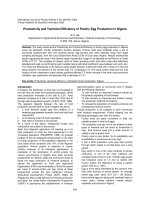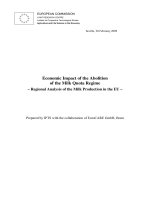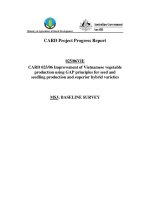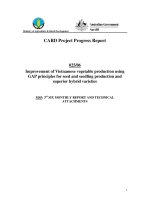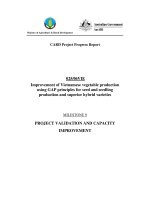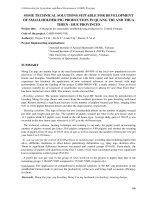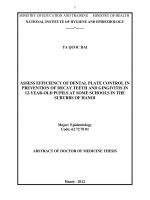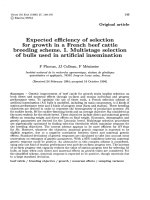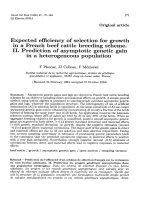Economic efficiency of organic vegetable production in kim long ward, hue city, thuathien hue province
Bạn đang xem bản rút gọn của tài liệu. Xem và tải ngay bản đầy đủ của tài liệu tại đây (562.89 KB, 70 trang )
Đại học Kinh tế Huế
ACKNOWLEDGEMENT
First of all, we would like to express the appreciation to our supervisorAssoc. Prof.
Dr. Bui Dung The. Dr. The already encouraged and directed us with his skillful guidance,
innovative idea and stoic patience. Without his help, we would never complete our
research.
We would like to acknowledge the valuable input of Dr. Nguyen QuangPhuc, who
helped to shapethis research, resolve the most difficult modeling in this research.
ại
Đ
We are very thankful to the professors and lecturers of the Advanced Program,
who have helped us and co-operated with us during the conducting time.
ho
We give deep thanks to all of households in Kim Long Ward who are enthusiastic
in supply us data and answer our questionnaire.
̣c k
Finally, we express to our family for their love and encouragement, we have
received so much personal support from family and friends.
h
in
Hue, October 2017
́
uê
́H
tê
i
Đại học Kinh tế Huế
TABLE OF CONTENTS
PART I: INTRODUCTION.................................................................................................................................1
1.
Rationale of this research ....................................................................................................................1
2.
Research objectives ..............................................................................................................................2
3.
Research methods.................................................................................................................................2
3.1.
Data collection ..............................................................................................................................2
3.2.
Analysis methods ..........................................................................................................................2
4.
Research scope......................................................................................................................................3
PART II: CONTENTS AND RESEARCH RESULTS.............................................................................4
Đ
Chapter 1: OVERVIEW ABOUT RESEARCH PROBLEM ..................................................................4
ại
1.1.
Theoretical analysis..........................................................................................................................4
What is organic agriculture? ....................................................................................................4
ho
1.1.1.
1.1.1.1. Motivation of growing organic agriculture ...................................................... 4
̣c k
1.1.1.2. Characteristics of organic agriculture ............................................................. 5
1.1.1.3. Basic criteria of organic agriculture ................................................................ 6
in
1.1.1.4. Quality standards of organic production .......................................................... 9
h
1.1.1.5. Why is organic vegetable necessary? ............................................................. 11
Definition of economic efficiency ...........................................................................................12
1.1.3.
Indicators reflect production results.......................................................................................13
́H
tê
1.1.2.
Practical basis .................................................................................................................................15
1.2.
́
uê
1.2.1.
Situation of organic agriculture model in the world..............................................................15
1.2.2.
Situation of organic vegetables model in Vietnam.................................................................17
1.2.3.
Situation of organic vegetables model in Hue city and Kim Long ward ...............................19
Chapter 2: ECONOMIC EFFICIENCY OF ORGANIC VEGETABLES PRODUCTION IN KIM LONG
WARD, HUE CITY, THUA THIEN HUE PROVINCE .............................................................................20
2.1.
Study site .....................................................................................................................................20
2.1.1.
Natural conditions.......................................................................................... 20
2.1.1.1. Geographical location .................................................................................... 20
2.1.1.2. Topography ..................................................................................................... 21
2.1.1.3. Climate ............................................................................................................ 21
2.1.1.4. Hydrological ................................................................................................... 22
ii
Đại học Kinh tế Huế
2.1.1.5. The resources .................................................................................................. 22
2.1.1.6. The situation of the environment..................................................................... 22
2.1.1.7. General assessment of natural features in Kim Long ward ............................ 22
2.1.2.
Current situation of using land in Kim Long ward, Hue City ..................... 23
2.1.3.
Economic and Social conditions ................................................................... 24
2.1.3.1. Economic growth and economic structure...................................................... 24
2.1.3.2. Population and labor ...................................................................................... 24
2.1.3.3. The infrastructure............................................................................................ 25
2.1.3.4. A general assessment of socio-economic features in Kim Long Ward ........... 26
2.2.
Organic vegetable producing situation in Kim Long Ward ...................................................26
Đ
Characteristics of surveyed households ........................................................ 26
2.2.2.
Technical process of organic vegetable production of surveyed households28
ại
2.2.1.
ho
2.2.3. Economic efficiency of organic vegetable production of surveyed
households.................................................................................................................... 35
Distribution channel of market for organic vegetable model in Kim Long
40
2.2.5.
SWOT analysis ............................................................................................... 43
in
̣c k
2.2.4.
Ward
h
Chapter 3: ORIENTATION AND SOLUTIONS FOR ORGANIC VEGETABLES PRODUCTION IN
KIM LONG WARD, HUE CITY,
THUA THIEN HUE ....................................................................46
tê
3.1.
Orientation of organic vegetable production in Kim Long ward .................................................46
́
uê
́H
3.2. Some of solutions to improve the efficiency of organic vegetables production in Kim Long
ward. 46
3.2.1.
Solutions about land........................................................................................ 46
3.2.2.
Solutions about infrastructure investment ...................................................... 47
3.2.3.
Solutions about labor ...................................................................................... 48
3.2.4.
Solutions about market.................................................................................... 49
3.2.5.
Solution about raising awareness about organic catering ........................... 50
PART 3: CONCLUSION AND RECOMMENDATION............................................................................52
1.
Conclusion...........................................................................................................................................52
2.
Recommendation................................................................................................................................52
2.1.
Recommendation for local government ...................................................................................52
2.2.
Recommendation for farmers ...................................................................................................52
iii
Đại học Kinh tế Huế
QUESTIONNAIRE FOR FARMERS WHO PRODUCE ORGANIC VEGETABLE MODEL IN KIM
LONG WARD – HUE CITY .......................................................................................................................54
REFERENCES...........................................................................................................................................61
ại
Đ
h
in
̣c k
ho
́
uê
́H
tê
iv
Đại học Kinh tế Huế
LIST OF TABLE
Table 1-1 : Square of organic agricultural of areas
16
Table 2-1 : Land using situation of Kim Long ward in 2015
23
Table 2-2 : The situation of population and labor of Kim Long ward over 2013-2015
25
Table 2-3 : Technical measures used in organic vegetable production
30
Table 2-4 :Pest and weed control methods
32
Đ
Table 2-5 : Type of vegetables grown follow twelve months
ại
Table 2-6 : Labor and average hour farm working of Smallholder Farmers
ho
Table 2-7 : Expenditures of organic vegetable model
34
35
36
̣c k
Table 2-8 : Price of some types of seeds
37
in
Table 2-9 :Gross output of organic vegetable of production of surveyed households
38
h
Table 2-10: Economic efficiency indicators of organic vegetable production
́H
tê
Table 2-11: Depreciation of fixed cost
Table 2-12: SWOT of organic vegetable model in Kim Long ward
39
40
43
́
uê
v
Đại học Kinh tế Huế
LIST OF FIGURE
Figure 1-1: Closed cycle of organic farm
5
Figure 1-2: Organic vegetable production process
7
Figure 2-1: The measures to improve plant health
33
Figure 2-2: Distribution channel of organic farms in Kim Long ward
41
ại
Đ
LIST OF IMAGE
20
h
in
̣c k
ho
Image 2-1: Map of Kim Long ward
́
uê
́H
tê
vi
Đại học Kinh tế Huế
ABBREVIATIONS
Action Center for the City Development
ADDA
The Danish Asian Agriculture Development Project
Cap
Capital
CAD
Canadian Dollar
DANIDA
The Danish Government
FAO
Đ
Food and Agriculture Organization of the United Nations
HDI
Human Development Index
ại
ACCD
International Organic Agriculture Organization
̣c k
IFOAM
Human Factors Integration
ho
HFI
Intermediate Cost
GMOs
Genetically Modified Organisms
GO
Gross output
GDP
Gross domestic product
GNP
Gross National Product
MARD
Ministry of Agriculture and Rural Development
MI
Mixed Income
NGOs
Non-Government Organizations
Pr
Profit
SWOT
Strength, Weakness, Opportunity, Threat
US
The United State
USDA
The United State Development of Agriculture
VA
Value Added
h
in
IC
́
uê
́H
tê
vii
Đại học Kinh tế Huế
VND
Vietnam Dong
TC
Total cost
ại
Đ
h
in
̣c k
ho
́
uê
́H
tê
viii
Đại học Kinh tế Huế
PART I: INTRODUCTION
1.
Rationale of this research
Constructing green agriculture towards using organic methods, biological
measures is friendly to environmental that were successfully applied in many
countries. It provides high efficiency in consumption, the export of agricultural
products, branding of agriculture products favored by consumers. Currently, the world
has 130 agriculture countries are under organic farming methods with approximately
35.6 million hectares of area, revenue of organic products worldwide reached about 55
billion US dollars (FAO statistic, 2015).
ại
Đ
Under the impact of urbanization progress to agricultural land, the level of
environmental pollution increases due to using more fertilizers, pesticides,...which
affect the value of annual agricultural production in Vietnam. Besides, misuse
chemicals in agriculture production also impacts on human health. In this situation, the
development of clean agriculture, high-tech agriculture will be right direction for
sustainable agricultural development.
̣c k
ho
h
in
Due to this circumstance, Thua Thien Hue province always care about growing
organic vegetables in a wide range.Two farmers in Kim Long ward was initial
successful with small scale pioneers in application of organic vegetables growing
model in ThuaThien Hue province. Especially, after perceiving the prospects of
organicmethod, local government in Kim Long Ward mobilize farmers to convert the
cultivated cropping patterns to expand the area planted vegetables according to this
method. They expanded organic vegetable model with 6 households include more over
3000 square meters of land.
́
uê
́H
tê
From 2015 until now, Kim Long's farmers not only improve their income but
also contribute to protect environment when they bring organic vegetables to
consumers in Hue city. With beginning 600 square meters of land, a farmer earned
about 150,000 VND each day on average. They also extensive farming on many types
of vegetable such as basellaalba, salad, fennel, and sweet potato buds, depending on
season. There are some problemswhich researchers should solve obviouslysuch as
what organic agriculture is. The result of this case study provides information about
organic vegetable production and its benefits. The study also shows how organic
vegetable in Kim Long Ward grow and develop from the beginning, and provides
smallholder farmers with the necessary information on profitability of organic
vegetable production system to facilitate making informed decision when converting
to organic farming. By determining the effect of social economic, farm and market
characteristics on profitability of smallholder vegetable production system, the study
1
Đại học Kinh tế Huế
assists providing additional way of increasing profit margins in smallholder vegetable
production systems and value chains. Capability of expanding organic vegetable
model to other wards in Hue is feasible.
Base on all above reasons weselect the topic:“Economic efficiency of organic
vegetable production in Kim Long ward, Hue city, ThuaThien Hue province” to
become our science research report.
ại
Đ
2.
Research objectives
General objectives: Assessing economic efficiency and expandability of organic
vegetables model at Kim Long Ward.
The study had the following specific objectives:
Codifying theoretical basis on organic vegetable production and
economic efficiency. From this basis, having more overall viewpoint about situation of
model organic vegetables in Kim Long.
Figuring out the process of planting the organic vegetables such as the
production, and expenditure cost, analysis the characteristic and situation of growing
organic vegetables in Kim Long ward.
Offerring some recommendations to enhance the efficiency of organic
vegetable in Kim Long ward and expand this model other wards of Hue city.
3.
Research methods
3.1. Data collection
Secondary data: is collected from books, magazines, professional
journals, the state policy is concerned, the scientific studies have been published, these
reports about economic effectiveness of organic vegetable production in local and over
the world; data is collected from ACCD, information are collected from the beginning
of converting conventional vegetable into organic vegetable.
Primary data: The questionnaire is designed to conduct the survey of 8
smallholder farmers, who growing organic vegetable in Kim Long ward, Hue city.
From the results of interviewing farmers, this research gathers information about area
under cultivation, process of growing organic vegetable, how to convert the model,
type of vegetable according to the season.
3.2. Analysis methods
h
in
̣c k
ho
́
uê
́H
tê
Analyzing economic- social issues as well as used the inputs of organic
vegetable grow, the results and the efficiency productivity of households over the
years.
Researchers docase study by describing detail farm households situation and
clarifying their activities. And then analyzing efficiency of households by answering
these questions such as what inputs are, how output price changes, what cost of
products is, what happen to famers or other factors such as weathers, seasons,…(what
2
Đại học Kinh tế Huế
seasons they can produce to get more profit, famers should consider, which kinds of
vegetables to produce more than one). Why the famers decide to produce in while the
market has many challenges to organic vegetables model and the way which
government (or some organizations) supports the households to sell products.
3.3.
SWOT analysis
In addition, because SWOT analysis is an important part of case study, it
is used to identify strengths, weakness, and the external environment as
opportunity and threats of framing activities. Therefore, researchers could provide
possible solution to overcome the difficulties of farmers.
Concern the concept of efficiency: gross output, value added, mixed income,
intermediate cost.
ại
Đ
4.
Research scope
Object of study: Organic vegetables model and farmers who applied the
model at Kim Long Ward, Hue city, ThuaThien Hue Province.
Time of study: Study and collect data in the period when smallholder
farmers have started model from May 2015 to April 2017.
Area: implemented inKim Long Ward, Hue city,ThuaThien Hue
province.
Scale: with over 4,800 square meters belong to 8 smallholder famers
who are growing organic vegetables models at Kim Long ward, Hue city, ThuaThien
Hue province.
h
in
̣c k
ho
́
uê
́H
tê
3
Đại học Kinh tế Huế
PART II: CONTENTS AND RESEARCH RESULTS
Chapter 1: OVERVIEW ABOUT RESEARCH PROBLEM
1.1. Theoretical analysis
1.1.1. What is organic agriculture?
1.1.1.1.
Motivation of growing organic agriculture
ại
Đ
Development is a growth process that consists of a variety of constituent
elements such as economics, politics, society, technology, culture, etc. The goal of
development is to improve conditions and quality of life of human, to make people
less dependent on nature, to create a fair and equal life among members. The
transformation of human society from primitive to slave society, then from feudalism
to capitalist society, etc., is a process of development. Development assessments are
usually based on a number of criteria. However, with each of type of development,
there are different criteria systems. For example: Assessing a country's economic
development is based on GDP, GNP, GDP / Cap, GDP / growth and GDP structure.
ho
h
in
̣c k
After a period of rapid development of world economies in the 50s and 80s of
the twentieth century, humanity is aware that economic measures do not adequately
reflect development. Instead of the only indicator that evaluates the development of
countries is GDP, GNP, there are more other indicators such as HDI, HFI, etc. The
rapid economic growth and the rapid increase in world population in the past decades
and our impact on the Earth's environment have led humanity to consider and evaluate
relationships: Human - Earth, socio-economic development - environmental
protection.
́H
tê
́
uê
Nowadays, human knew that the Earth's natural resources are not endless,
impossible to exploit indiscriminately and the ability to assimilate waste from the
Earth's environment is limited. Therefore, humans need to live in harmony with nature.
It is necessary to account for common good of the community, of future generations
and costs of environment for development, etc.
On the other side, development in biology refers to the physical accumulation
of biological objects to produce the final product. For example, growth of plants is the
process of accumulation, reproduction, and yielding of plants. In breeding,
development is the maturity in the physiology to perfect the reproductive function. All
of these requirements lead to the emergence of a human notion that is: Sustainable
development. Sustainable development is a development that will satisfy the growing
needs of the present generation without compromising the ability to satisfy needs of
future generations. According to sustainable development, human are starting to
4
Đại học Kinh tế Huế
research in order to have effective solutions to prevent the negative trends from
intensive farming. One of the most effective solutions is to make the agricultural
production process follow the law of inherent biological nature. From that, organic
agriculture and bio-agriculture were constituted.
Organic agriculture is a production system that sustains the health of soils,
ecosystems and based on the principles set in the International Standard (IFOAM). It is
a method of growing plant without using any toxic substances such as pesticides, weed
killers as well as chemical fertilizers.
1.1.1.2.
Characteristics of organic agriculture
Organic agriculture has the following characteristics (Haccius, 1996; Alsing,
1995):
ại
Đ
- Agricultural production in the direction of ecological system. Humans, land,
plants and livestock are all within a unity, as an organism.
- The basic idea of organic agriculture is that economic activity must be in
harmony with nature. These activities will have bad consequences and will not
develop sustainably if they are not follow natural laws.
- Production will develop well on the basis of using and enhancing the natural
fertility of the soil as well as increasing the resistance of plants and animals to pests.
- Breeding is an important adaptation component of organic agriculture.
- Farming systems are unaffected by the use of off-farm materials such as
inorganic fertilizers and plant protection chemicals.
Organic farm produce agricultural products by below close cycle:
h
in
̣c k
ho
́
uê
́H
tê
Figure 1-1: Closed cycle of organic farm
(Source: GiaotrinhNongNghiephuu co, Agricutural Publishing House, 2013)
5
Đại học Kinh tế Huế
Close cycle of organic farm, Neuerburg W. and S. Padel (1992) illustrated and
explained the fundamental principle of organic agriculture. It shows that organic
agriculture farms should coordinate the cycle life and natural system by combined
livestock suitably for cultivated area. They should encourage and promote the
biological cycle in the farming system, including micro-organisms, flora and fauna in
soil; maintain and increase soil fertility in long term by using dung of cattle, plants,
cattle feeds. By applying organic manures from breeding of farm households, plants
would be provided nutrition easily. In addition, diversity rotation could prevent pests
effectively.
Conditions for producing organic vegetables:
ại
Đ
Vegetable production sites must be located in safe production areas as
regulated by the Ministry of Agriculture and Rural Development. This regulation
assesses soil and water quality without being contaminated with toxic chemicals,
heavy metals, etc.
Vegetable production sites are not in flood-prone areas, not in industrial
zones.
Any citizen can participate in growing organic vegetables to protect the
health of the community and protect the ecological environment.
1.1.1.3.
Basic criteria of organic agriculture
Organic agriculture is an agricultural form that avoids or eliminates most
of the use of synthetic fertilizers, pesticides, plant growth regulators, and additives in
animal feed. Organic agriculture relies on natural cycles and systems adapted to local
conditions, combination of tradition, innovation and science in production systems that
promote fair relations along supply chains (IFOAM, 2004).
The primary goal of organic agriculture is to maximize the health and
productivity of independent communities in terms of livelihoods, crops, livestock and
humans.
According to International Organic Agriculture Organization, IFOAM:
"The role of organic agriculture, whether in cultivation, processing, distribution or
consumption, is to maintain the health of ecosystems and livelihoods, animals from the
smallest organisms live in the soil to humans."
In general, organic farming will improve and maintain natural landscape and
agricultural ecosystems, avoid overexploitation and pollution of natural resources,
minimize the use of non-renewable energy and resources, produce nutritious, nontoxic, and high quality food... In addition, it ensures, maintains and increases soil
fertility in the long run and strengthens the biological cycles of the farm, especially the
nutrient cycles.
h
in
̣c k
ho
́
uê
́H
tê
6
Đại học Kinh tế Huế
Organic agriculture is a mode of agricultural production based on the use of
biological processes in nature. In other words, organic agriculture is a mode of
production in which production processes apply by natural biology.
Organic agriculture is not only an agricultural without chemical, but also it is
full of ecological, social and economic sustainability. Therefore, it is a sustainable
form of agriculture. That means that organic agriculture is a way of maintaining an
ecological balance in the farming system and using the available resource in a
sustainable manner with a special attention to the socio- economics of production.
Reconstitution of nutrient cycles, optimal use of available resources, diversification is
an important ecological aspect of organic agriculture. Socio-economic aspects such as
food safety, fair trade, increased resources etc. are also important aspects of organic
agriculture.
Organic agriculture is growing more and more because:
Đ
ại
- Resolve the conflict between intensive farming and environmental issues.
Organic agriculture has increased the use of natural seedlings and diversity of
agricultural production. It also has reduced the pollution of soil, water and agricultural
products because it did not use inorganic fertilizers, plant protection drugs, and breed
feeds.
̣c k
ho
h
in
- Organic farming ensures, maintains and increases long-term fertility of the
soil, consolidates of biological cycles in the farm, especially nutrient cycles. Besides, it
protects crops based on prevention instead of curing, diversifying crops and livestock
types suitable to local conditions.
tê
Organic vegetable production process:
(1)
Land
preparation
(2)
Production
planning
(3)
Fertilizer
preparing
( 4)
Preparation
of
irrigation
water
́
uê
́H
- Resolve human needs like clean eating, beautiful and clean environment.
Clean foods are those that contain nutrients content as in nature.
(5)
Pest
control
(6)
Planting
and tending
organic
vegetables
(7)
Record
Figure 1-2: Organic vegetable production process
(Source: Green Life Vietnam, 2012)
7
Đại học Kinh tế Huế
(1)
Land preparation:
Isolate organic lands with other lands by grass. In other words, it is necessary to
create a buffer zone to separate from the normal production land. Isolation will help
prevent harmful chemicals from pesticides or chemical fertilizers from spreading to
the organic farm.
(2)
Production planning:
An indispensable requirement of organic production is crop rotation. With the
support of the ADDA project and the agricultural engineer of the company, farmers
grouped vegetables together: leaf group, fruit group, legume group... and then plan
rotation. This measure helps the vegetables to avoid pests and diseases. It also helps
using more balanced nutrients in the soil.
Preparing fertilizer:
Đ
(3)
ại
The first requirement of organic production is not allowed to use inorganic
fertilizers (chemical). To compensate for vegetable nutrients, farmers have to compost.
Composting materials include:
ho
Manure such as chicken manure, pig manure, cow dung ...: provide
̣c k
Green materials such as leafy vegetables, fresh grasses: provide minerals
Brown materials such as straw, dried leaves: potassium supply
h
in
protein
-
́H
tê
The above materials must be mixed together and heated for 2-3 months until
completely rot.
́
uê
In addition, during the annealing process, the microbial respiration produces
heat. Therefore, the internal temperature of the compost can be as high as 60 ° C to 70
° C, depending on each stage, so pests and diseases are eliminated during composting
and weeds will no longer germinate. The compost is then applied to the soil. Fresh
feces and urine are strictly prohibited in organic production regulations. All the above
ingredients must be heated before applying to the soil.
(4)
Preparation of irrigation water:
Irrigation in organic production, especially in vegetable production, is very
important. Irrigation water sources must ensure the non-contamination of agricultural
and industrial chemicals in the area. Therefore, the organic production areas must dig
wells or get direct water from the tap into the field.
8
Đại học Kinh tế Huế
(5)
Pest control:
Chemical pesticides are strictly prohibited in organic production. Instead,
farmers must apply folk remedies, or biological ones, such as extracting garlic, ginger
to eliminate pests. In addition, growing vegetables which can entice or repel insects
must also be applied around organic vegetables. Another important feature of organic
vegetables is that they usually stronger than the common vegetables, so the resistance
to organic vegetables diseases is much higher.
(6)
Planting and tending organic vegetables:
ại
Đ
The principle of growing and tending organic vegetables is not different from
the usual. However, growing organic vegetables requires more labor because it must
prepare all production materials from buffer zone, fertilizer, irrigation to preventive
measures. In addition, farmers are not allowed to use herbicides so they have to do the
grass completely by hand.
ho
(7)
Records:
h
in
̣c k
Organic farming management requires the farmer to keep a record of all input
materials, measures to be taken during the cultivation process. Farmers must also
record crop yields. This information shows the transparency in organic production,
which avoids the reuse of chemicals.
́
uê
́H
tê
Because it is not allowed to use genetically modified varieties, growth
stimulants, the growth time of organic vegetables is longer than that of normal
vegetables. For example, for leaf vegetables: if there is enough fertilizer, chemicals,
the time from sowing to harvest is about 25 days. Meanwhile, vegetables produced by
organic process will take 35 days. This has a great impact on the quality of vegetables.
Longer growing times and longer photosynthesis time help organic vegetables to
accumulate higher nutrients, higher levels of vitamins and give them a more
distinctive, rich flavor.
1.1.1.4.
Quality standards of organic production
These standards are based on National standards on organic production and
processing (10TCN 602-2006), issued by the Ministry of Agriculture and Rural
Development (MARD) (2006a).
1. Water sources used in organic vegetables production must be clean and
unpolluted water.
2. The organic production area must be well isolated from polluting sources
such as factories, industrial zones, construction sites, major roads, etc.
9
Đại học Kinh tế Huế
3. Ban on the use of chemical fertilizers in organic production.
4. Ban on the use of plant protection chemicals.
5. Ban on the use of synthetic growth stimulant.
6. The spray equipment used in conventional cultivation is not used in organic
farming.
7. Tools used in conventional farming must be cleaned before being used in
organic farming.
8. Farmers must maintain records of all input materials used in organic farming.
9. Parallel production is not allowed. Organic crop plants must be different
from conventional field crops.
Đ
ại
10. If neighboring land uses organic substances banned in organic farming,
organic soils must have a buffer zone to inhibit the infiltration of chemicals from
adjacent fields. Organic vegetables must be planted at least one meter (01 m) from the
buffer zone.
̣c k
ho
h
in
If infections take place through the air, there should be a plant grown in the
buffer zone to prevent. The type of plant in the buffer zone should be different from
that of the organic crop. If infections take place through water, there must be a
shoreline or drainage ditch to avoid infections by spilled water.
́H
tê
11. Short-term crops produced in accordance with the organic standards of a
complete life cycle from tillage to post-harvest can be sold as organic products.
́
uê
12. Perennial crops produced by organic standards complete a life cycle from
the end of the previous harvest to the flowering and harvesting of the next crop that
can be sold as organic products.
13. It is forbidden to use all input materials containing Genetically Modified
Organisms (GMOs).
14. Available seed and organic material should be used. If not available, it is
possible to use conventional planting materials but it is prohibited to be treated with
chemical pesticides prior to sowing.
15. Burning branches and straw are prohibited except for traditional shifting
cultivation.
16. It is forbidden to use human excreta.
10
Đại học Kinh tế Huế
17. Animal dung that is get from outside the farm must be tempered before use
in organic farming.
18. It is prohibited to use compost made from urban waste
19. Farmers must take measures to prevent soil erosion and soil salinization.
20. Bags and containers for the transportation and storage of organic products
must either be new or cleaned. Do not use bags and banned substances in organic
farming.
1.1.1.5.
Why is organic vegetable necessary?
ại
Đ
Organic vegetables has more of the antioxidant compounds linked to better
health than ordinal food, and lower levels of toxic metals and pesticides, according to
the most comprehensive scientific analysis to date. The team led by Professor Carlo
Leifert at Newcastle University, concludes that there were "statistically significant,
meaningful" differences, with a range of antioxidants being "substantially higher" –
between 19% and 69% – in organic food. It is the first study to demonstrate clear and
wide-ranging differences between organic and conventional fruits, vegetables and
cereals. Besides, it must ensure farming vegetables with natural conditions: No
chemical fertilizing, do not spray plant protection, do not spray growth, do not use
herbicides, do not use genetically modified products.
in
̣c k
ho
h
Organic vegetable growers are highly trained in how to vegetable, care for and
preserve vegetables and soil, and in selection irrigation water that is not polluted by
heavy metals (mercury, arsenic, etc.) and is not affected by industrial wastewater (due
to the nearby factories, untreated sewage vegetables).
́H
tê
Nutritional quality and safety of organic versus conventional produce:
́
uê
Nutritional value of organic vegetables: Organic foods contain more
nutrients than other foods. Antioxidant content in organic fruits and vegetables ≥ 40%
compared to normal (according to researchers at Newcastle University). Organic foods
contain more minerals that are more beneficial to the body (iron, zinc, etc).
However, other recent systemic reviews of nutrition and health effects of
organic foods conductedin the US have revealed few health benefits from consuming
organic foods. Another recentstudy by the American Academy of Pediatrics examining
the potential health and environmentaladvantages and disadvantages of organic foods
revealed the following: due to a lack of controlas well as other issues with
measurement, nutritional differences between organic and conventionalproduce appear
to be minimal; organic produce contains fewer pesticide residues, but it
remainedunclear how clinically relevant this is.
11
Đại học Kinh tế Huế
In terms of safety, there seems to be a consensus in literature that organicallygrown fruits andvegetables tend to have lower incidences of pesticide residue
contamination and lower levels ofnitrates. In the United States, according to the latest
(2013) report from the USDA, more than99% of all products sampled by the program
had pesticide residues below the EPA tolerance. However,this report did not
distinguish between organic or conventional production. It simply designated
thesample as domestic, imported, or unknown. It is notable that fresh and processed
fruit and vegetablesaccounted for 84% of the 10,104 collected samples for pesticide
analyses. More than 40% of the sampleshad no detectable pesticide residue. Produce
with detectable pesticide residues (5%) included bananas,broccoli, carrots, cauliflower,
celery, green beans, mushrooms, nectarines, peaches, plums, raspberries,and summer
and winter squashes.
ại
Đ
Experts agree that quality (including nutritional quality) and safety of fresh
produce is a complexissue which is affected by a variety of factors, such as
environmental conditions, production practices,postharvest processing and handling,
and bioavailability after consumption. The compositional differences between organic
and conventional produce depends on productionpractices and surrounding
environments for both systems. In addition, postharvest processing, storage,handling,
preparation, cooking, and processing prior to consumption all affect nutrition,
bioavailability,and functionality.
in
̣c k
ho
h
Once produce is consumed, only certain amounts of nutrients are absorbedinto
the human body, bloodstream, or targeted tissue and reach clinically relevant levels. It
seemsthat comparing the absolute difference in the nutrients of fruits and vegetable
grown under differentproduction methods may not be sufficient. Many experts have
suggested conducting further research,looking at a broader range of nutrients and
potential impact on human health outcomes.
́
uê
́H
tê
1.1.2. Definition of economic efficiency
Economic efficiency of production and business activity is an economic
category reflects the level of use resource (labor, machinery, equipment, raw materials
and working capital funds) to achieve the goals that the business has identified.
Economic efficiency reflects the level of exploitation of investment factors, natural
resources and management methods. Economic efficiency expression the relational
comparison between economic results achieved with economic cost spent.
There are some different views on economic efficiency, but we can summarize
three views as follows:
o
The first point is that economic efficiency is determined by the ratio
results obtained and cost spent
12
Đại học Kinh tế Huế
H=
In which,H: economic efficiency (times)
Q: results obtained
C: cost
This method reflect efficiency of the use of resources of a given business
process, considering how much of a resource unit has been used. On this basis, they
assess the economic efficiency between production units, different product sectors and
different periods.
If only focus on this view is not comprehensive, the ratio between production
results and cost is relatively, this indicator has not analyzed the impact of human
resources factor.
ại
Đ
o
The second view considers economic efficiency in the volatility between
cost and production. In this view, EE is expressed in the term of the ratio between the
increase in output and increase in cost.
∆
∆
In which,∆Q: An incremental output
∆C: An incremental cost
̣c k
ho
H=
h
in
This view is not complete yet. In fact, resulting production is always
consequence of cost available plus additional cost. At different additional cost level
available, the effectiveness of additional cost varies.
́
uê
́H
tê
Each view has its own advantages and disadvantages. If only economic
efficiency is measured in terms of profit (revenue minus cost), productivity cannot be
determined. However, the ratio between revenue and cost is just relative indicator. It
has not yet analyzed the impact and influence of resources. Therefore, when analyzing
economic efficiency, it is necessary to combine the indicators to reflect both the level
and the scale both reflecting the quality of the entire production process. We have to
consider in all aspects to have a comprehensive, accurate view, depending on the
purpose and requirements of the study.
However, due to limited time and especially the suit of the model, we only
studied the first view. The second is for reference purpose only.
1.1.3. Indicators reflect production results
o
Gross output: (GO): is an economic concept used to measure total
economic activity in production of household. It’s monetary value of all products of
farmers in a given period.
GO is only calculated to products which household produce and sale to other
producers or consumers. It is not includes products used for in internal farm or for
13
Đại học Kinh tế Huế
other process of production. Profit from arbitrage does not account for. Besides,
subsides account for GO.
GO consists of intermediate cost (IC), income of labor, depreciation of fixed
asset and surplus of production. There are some methods to calculate GO. One of those
methods applied in agricultural sector is:
GO = ∑
In which, Qi: quantity of ith product
Pi: price of ith product
In addition, there are some other methods, such as:
-
Measuring GO based on revenue:
GO= Gross revenue + subsidy +/- difference of beginning & ending of inventory.
Đ
-
Measuring GO by sale revenue and cost of goods sold
ại
GO = Total cost + profit + subsides
ho
in
̣c k
o
Intermediate Cost (IC): is a part of total cost including costs for
manufacturing and services (excluding depreciation fee) and cost of services.
o
Value added (VA): is the whole added value compared to the cost of
production (without depreciation)
VA = GO – IC
h
Value added includes:
́
uê
́H
tê
IC would be calculated by price of selling; GO follows basic price or market
price; VA would follow price of GO.
+ Income of labors which consist of salary, wages (involve paying by
products), security, subsidy, etc.
+ Other tax: tax paid by corporation.
o
Depreciation of fixed asset:
Cost of constructing the irrigation system, the composting houses are
depreciated over 5 years.
Expenditures for equipment are depreciated over 4 year.
Cost of land rent is calculated according to average price in local.
o
Surplus value involves gross income of business, playing interest in
bank and insurance asset
o
Mixed income (MI): is an indicator of result of household’s farm activity
without deducting family labor.
14
Đại học Kinh tế Huế
MI = VA - fixed assets depreciation – Tax
o
Profit (Pr): Gross output minus total production cost
Pr = GO – TC
Profit is mixed income remaining after deducting family labor cost and family
artifacts costs.
Pr = MI – family labor cost – family artifact cost
ại
Đ
Economic efficiency indicators significance
o
Gross output per intermediate cost (GO/IC): is the ratio of value of
output per unit cost, it means for 1 unit direct cost spent can create how much value
produced during a period of time.
o
VA/IC is the ratio of value added per unit of cost or reflects that for each
unit direct cost spent can create how much value added. In the other word, when
increasing 1 unit of intermediate cost, we will find how much value will be gained.
o
MI/IC: is the ratio of mixed income per each intermediate cost. With
each unit cost of intermediate cost, we can get how much value of mixed income.
o
Pr/TC: each unit cost spent farmer can get how much money.
1.2. Practical basis
1.2.1. Situation of organic agriculture model in the world
in
̣c k
ho
h
The world has more than 37 million hectares of organic farmland with 1.6
million production facilities. The total value of organic world market is estimated at $
63 billion in 2012, compared to the official agricultural market of $ 1,362 billion in
2010.
́H
tê
́
uê
In 2010, 160 countries were certified organic farming. In terms of area, 37.3
million hectares of organic agriculture occupy 0.9% of the area of global agricultural
land, of which two thirds (23 million hectares) is grass land and cattle grazing. There
are 2.72 million hectares of organic farming of annual crops, including 2.51 million
hectares of cereals (including rice) and 0.27 million hectares of vegetables. The area of
organic perennial crops is 2.7 million hectares (0.6% of total organic farming area), of
which the three most important crops are (0.64 million hectares), olives (0.5 million
hectares) and oilseed crops (0.47 million hectares). There are 7/160 countries that
achieve more than 10% organic farmland. Europe has an area of organic land of about
10 million hectares with about 280,000 farmer households, followed by Latin America
with 8.4 million hectares, Asia with 2.8 million hectares, North America with 2.7
million hectares and Africa with over 1 million hectares. Certified organic lands
occupy 0.9% of the world's agricultural land.
15
Đại học Kinh tế Huế
Table 1-1: Square of organic agricultural of areas
Unit: million hectares
Year
Area
2004
2008
2009
World
14.90
29.77
35.23
37.23
Australia
5.31
12.18
12.11
12.15
Europe
4.50
6.35
8.27
9.26
Latin America
3.92
5.22
8.07
8.56
Asia
0.06
3.78
3.35
3.58
1.06
1.72
2.65
2.65
0.05
0.52
0.86
1.03
North America
ại
Đ
2000
ho
Africa
Europe
in
̣c k
(Source: GiaotrinhNongNghiephuu co, Agricutural Publishing House, 2013)
h
European region currently has 10 million hectares of organic farmland with
about 219,431 households and farms. Countries with large organic farmland are: Spain
(1.46 million hectares), Italy (1.113 million hectares), Germany (0.99 million
hectares). Seven countries have achieved 10% higher organic agricultural land are the
Principality of Liechtenstein (27.3%), Austria (19.7%), Sweden (12.6%), Estonia
(12.5%), Switzerland (11.4%) and Czech Republic (10.5%). European organic
industry has a market value of € 19.6 billion (2010) with an annual growth rate of 8%.
The largest organic markets are Germany, France, England and Italy.
́
uê
́H
tê
Americas
The US organic sector has a market value of about $ 29 billion, accounting for
3.5% of the national food market. The US has 1.9 million hectares of USDA organic
certification with 12,941 manufacturing facilities and 17,281 farms. US exports 23
organic goods, mostly fresh fruits & vegetables, baby food, drinks. The Canadian
organic industry has a market value of about 2.6 billion CAD. Canada has 703,000
hectares of organic certified and 3929 certified farms .45% of organic products are
sold in supermarkets, 25% of which are organic.
16
Đại học Kinh tế Huế
Asia
Japan: Organic market in Japan is the largest, most organized, and the most
sophisticated market in Asia, accounting for 67% of the organic market in Asia.
Japanese consumers are also extremely strict, and very concern about the quality of
products compared to any consumer in the world.
China: China is the strongest organic growth market in the region. In China,
safe and environmentally friendly food is sold under the "green food" label, which
includes "non-polluted food / hazard-free food", "green food" "and" organic food", the
most valuable of which is organic food. The" green food "market in China is worth
about $ 12 billion (2012), with about 2.03 million hectares certified.
ại
Đ
India: Organic land area is about 1.18 million hectares (2009), mostly used for
cotton. However, India's organic area is falling due to high organic cotton prices,
which has led many farmers to convert to conventional cotton.
̣c k
ho
South Korea: Focused on rice, South Korea is also actively campaigning to
develop organic agriculture on traditional agriculture in plow and animal husbandry.
South Korea has 32,000 certified organic production facilities and farms (2000). South
Korea's organic market in 2010 will reach 4 trillion won, and if annual growth
continues to grow at 26% per year (2013)
h
in
Singapore: Singapore is a country without agriculture. Most organic products
are imported. In addition, there is a very limited amount of organic produce produced
domestically. The size of Singapore's organic market is small, only $ 5 million.
́H
Australia
tê
́
uê
Australia is the largest organic area in the world. More than half of the world's
organic agriculture is grassland with 22 million hectares, with Australia accounting for
more than 30 percent. In addition, Australian organic agriculture also has the largest
certified acreage in the world: 11,199,577.4 hectares from 3,069 business units out of a
total of 13,637,541.9 hectares of total organic agricultural area (2012).
Africa
There are 1.1 million hectares of organic farmland certified with about 544,000
farms. Africa's main organic producers are Uganda (228,419 hectares), Tunisia
(175,066 hectares) and Ethiopia (137,196 hectares).
1.2.2. Situation of organic vegetables model in Vietnam
The concept of organic farming in Vietnam is quite strange and new. However,
our country's agriculture is facing many challenges such as environmental pollution,
17
